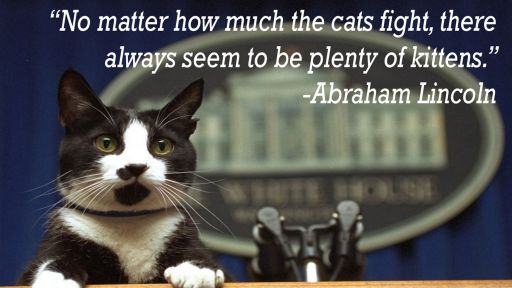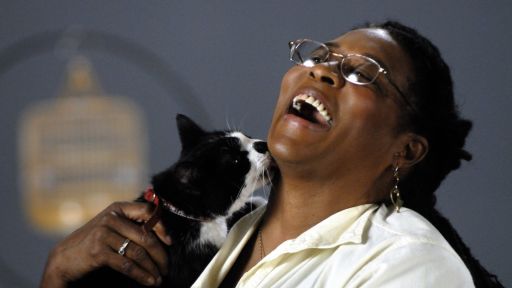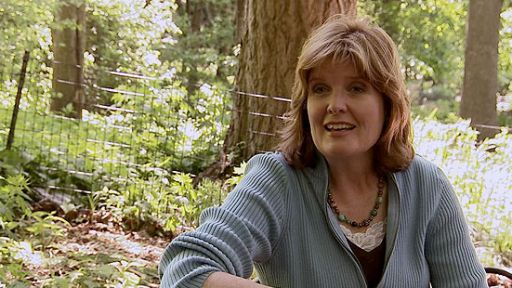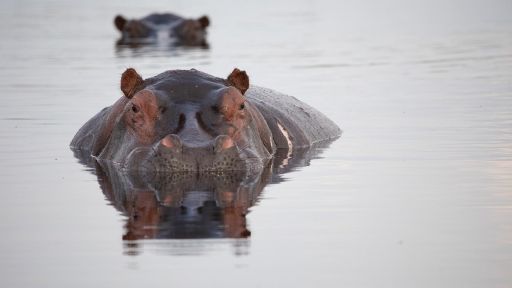Jim Nelson and René Agredano dropped everything to travel with their dog, Jerry. To get Jerry’s full story, NATURE spoke with René in February 2009.
Where did you get Jerry? Did you adopt him from a shelter?
We adopted him in January 1999, from the Sequoia Humane Society in Eureka, California (located just south of the Oregon border, in Redwood country). Someone had left the poor little guy in the “drop box” outside the shelter when he was hardly a few weeks old. Little did they know when they ditched him that they had a superstar on their hands!
Jerry had lingered at the shelter for over two months. Maybe he scared people off because he kept destroying all his toys in his kennel. We couldn’t believe nobody had adopted him yet, and he was the only one who ran up and kissed Jim.
Why did you decide to get a puppy? Did you have any other pets at the time or before Jerry?
I’m always a sucker for a hard luck case, and I originally wanted an older dog. But Jim persuaded me to take home a pup. Jerry was our first dog, and as new pawrents, we had a lot to learn. Jim felt that we might not be ready to take on the challenges that an older dog can bring. Now I know he was right. Jerry taught us well, so now we can handle any dog that comes into our lives.
Can you tell us about Jerry’s time as a certified therapy dog?
We would take Jerry to visit Jim’s convalescent mother. It would make her day, and his. Jerry loved meeting new people and spreading smiles around. Later we had Jerry certified with Therapy Dog International so we could continue to visit nursing homes. His license also helped us get him into a restaurant or two.
What about Jerry made him a good therapy dog?
Well, it helped that he was tall enough for people in wheelchairs to reach over and pet. And because he truly loved meeting new people so much, his eyes just shined whenever we would take him into a facility. He would smile, his tail would wag wildly, and he would just stand there and allow the old folks to just stroke and pet him as long as they wanted to. I truly think he understood that the patients needed love and fur in their lives.
He was a glutton for all the loving. But being a gentle giant, he was also great in tense situations with mentally challenged patients, and wonderful with children.
What was Jerry’s favorite toy?
Why, isn’t this funny; it was BARNEY! Yes, the big purple PBS dinosaur! Years ago we picked up a Barney doll at a yard sale, and as soon as we showed it to Jer, he was all over it! Barney was the one toy he would always toss in the air or grab in his mouth to show visitors who came to the door. Pretty soon we started a collection of over a dozen different Barneys, from a three-foot-tall one to mini “travel Barneys” that would ride in the truck with him. Oh, and the talking Barneys would make him go positively nuts!
As we traveled the country with Jerry, he would give away his Barneys to other Tripawds we met on the road. It makes us happy to know that these dogs got to enjoy them as much as he did.
What were your first thoughts and feelings when you found out Jerry was sick?
Devastated. Shocked. Robbed of time together. I couldn’t believe that we were not going to get to see Jerry live out his days as a mellow, wise old senior dog. When you adopt a dog, you have this vision of you and the dog growing old together. I can accept the fact that dogs live shorter lives than we do, but having a doctor give me what at first I considered a death sentence, when I least expected it, really knocked the wind out of me.
As an adult, neither of us had ever dealt with losing a pet. Jerry was so much more than a “pet” though. We were going to lose a family member. He was our first and only four-legged pack member. To discover he needed an amputation — and fast — made us angry, scared, and worried. But we knew we had to do the right thing immediately, for him.
Did Jerry’s cancer ever seem to affect his temperament?
Never. Jerry dealt with his cancer better than any human we know of. He never complained, got cranky, or lost his will to enjoy every day to the fullest. I believe that he knew he was not well. Watching him cope with his changing body taught me a lot of lessons about how to cope with adversity.
His temperament only changed a bit until the end days when he told us he was ready to go. But even then, he had spirit, and a wagging tail. One of the most important lessons Jerry taught us is that every day is a great day. We must live each one to the fullest.
Were there any questions about whether or not to go through with the surgery to amputate Jerry’s leg? What was his recovery like?
Oh yeah. Neither one of us had ever seen a three-legged dog before. We had no idea that dogs could thrive this way. The orthopedic surgeon at the University of California at Davis’ vet teaching hospital told us we had two options to help him: amputate and get him out of the immediate pain he was in, or take him home, drug him up with painkillers and let him live out the next few weeks in a dopey haze.
We didn’t decide to amputate when it was first proposed to us. We spent time talking about it during the six-hour drive home from Davis. Going forward with the amputation meant that our lives together would change forever. We figured Jerry would no longer be the happy hiking dog that he was. He would have limitations, and we didn’t know if we were strong enough to cope with it.
It wasn’t until we saw a video of Moose, a three-legged Harlequin Great Dane, digging away for gophers, that we felt confident that if a giant dog like Moose could be happy on three legs, so could Jerry. We contacted Moose’s pawrent, and he was incredibly helpful by talking to us and giving us a realistic picture of what life is like for a tripawd. If it wasn’t for Moose, I don’t know if we would’ve gone ahead with it. We were so scared for Jerry.
Ultimately though, we realized that if it were a human child of ours facing this, there would be no doubt that we would go forward with the surgery. Well, to us, Jerry was our fur kid — we decided to go ahead and do it.
We didn’t have much time to decide. Davis has a huge waiting list, and there was a surgery cancellation just a few days after his diagnosis. We were told we could do it then, or wait until another spot opened, but that wouldn’t happen for at least a month. At that point, we stopped hesitating and went for it.
How long after you found out Jerry was sick did you decide to travel? How did the idea to do something so drastic come about?
We found out Jerry was sick just before Thanksgiving of 2006. We knew right away that if his time was so limited (vets gave him a three to four month prognosis), then we needed to act quickly so we could live our dream of traveling the country with him.
We always had a goal of selling the graphics business we started. But time got away from us, and before we knew it, almost ten years had gone by and we still weren’t any closer to the goal. Jerry’s illness came as a mixed blessing; it was the kick in the butt we needed to break away and start living life with him.
In December 2006, we finalized our business prospectus, and started marketing it ourselves. By February of 2007, we were extremely blessed to have found a buyer who wanted both our house and the business. By June 3, the deal was done, and we hit the road with Jerry.
We truly feel that everything happens for a reason, and the fact that the universe made this happen for Jerry is a sign that he was meant to go out and show humans how great three-legged dogs get along.
What did your friends and family think about you totally changing your lives to travel with your dog?
Nuts. Wacko. Insane. All of the above. Well, not everyone did. Those of us who consider our dogs our children, know exactly why we had to do it. But then we got feedback from others who thought that spending what we did on just the amputation alone was crazy. I feel sorry for them. They are really missing out on all of the lessons that dogs are put here to teach us.
Society teaches you that taking time off like this is something that needs to wait until you’re retired. We figured, since we don’t have much of a retirement fund anyway, we’re probably always going to be working. So why not take a long break like this, with someone we love, before we’re too old and decrepit to enjoy it?
What’s your best memory of life on the road with Jerry?
For me, that one is easy. The day he put his paws in the Atlantic Ocean at Acadia National Park, in Maine. It was truly a milestone to be there with him. Back home on the coast in Northern California, hardly a week went by when Jerry wasn’t splashing in the Pacific. To see him get to set paw in the Atlantic, almost one year after his diagnosis, brought tears to my eyes. I don’t think he realized how special that was; after all, he was just excited that he got to see the ocean again after not playing in it for many months! Seeing him swim in the Gulf and the Great Lakes along the way was icing on the cake.
What was his favorite place that you traveled to?
If Jerry could answer that, I think his favorite place was Lake City, Colorado. In summer 2008, we worked at a dude ranch in a small mountain town at 9,300 feet above sea level. It’s paradise for dogs there! Not only was it the most beautiful scenery we had ever seen, but the whole time we were there, Jerry was never on a leash. Everyone there loved dogs, including the owners, and Jerry was free to hang out wherever he wanted to. He even worked with us when he was feeling energetic enough. There were horses, and deer and not a single flea to be found! We swam in mountain lakes, camped in a tent like the old days, and had a beautiful summer with him. It was the perfect place for us to spend our last months together.
You found a great oncologist in Santa Fe. Can you talk about how your experience with Jerry’s doctor affected your decisions about treating Jerry’s cancer?
It’s funny how things turn out. If we had met Dr. Mullins when Jerry was first diagnosed, we probably would have gone forward with chemotherapy for him. But at the time, we didn’t encounter any vet who could convince us that Jerry would have a decent quality of life, and still go through treatment. It wasn’t until 16 months after he was diagnosed that we met Dr. Mullins, who presented us with a type of chemotherapy treatment that we could give to him on the road.
One of the things she said to us was basically “We don’t want to pump your dog up with chemotherapy just to keep him alive; the goal is to give him a great quality of life.”
Before then, we always assumed that chemotherapy would be aggressive, sort of a “win at any cost” kind of war. Little did we know that there are oncologists out there like Dr. Mullins who always place the dog’s quality of life first. We were very naive until we met her.
Dr. Mullins clearly explained our various treatment options after discovering the cancer had returned in Jerry’s lungs. We were happy to learn of an oral chemo pill we could administer ourselves on the road. There was no way we were about to settle in somewhere for regular IV chemo treatments or put him through another surgery. The pill was part of a new metronomic protocol that had proven promising in other cases. We were also able to participate in a clinical trial for K9 Immunity, a popular herbal supplement for cancer dogs.
Dr. Mullins made the shocking news of Jerry’s lung mets bearable. She was honest and upfront, yet eased all our old worries that had swelled up reminding us of the terrible times during his diagnosis, amputation and recovery.
The film leaves you and Jerry after the visit to the oncologist in Santa Fe. Can you tell us about Jerry’s life after that?
We traveled around a bit in New Mexico for a couple months, and worked as seasonal help at a hot springs resort. (That place was not very dog friendly, and Jerry didn’t like being cooped up while we worked three days a week. We left after just about a month).
Then, we toured more of Colorado, where we met another three-legged dog – a working sled dog! – and ended up in the southwestern corner, Lake City, to work at the dude ranch for the summer months. Clearly, Jerry’s favorite place was Colorado. It was the one part of the country where he swam the most, and got to enjoy the great outdoors more than ever.
Coincidentally, when we left the ranch and Jerry needed to see a cancer specialist for an urgent check-up, Dr. Mullins had just relocated to a practice in Denver as their board certified oncologist. Jerry was her first patient at that clinic. She altered his treatment plan to improve his quality of life, which enabled us to spend another month with Jerry, exploring the Grand Tetons and Yellowstone National Park.
How were you able to help Jerry with his physical limitations near the end of his life?
Jerry really didn’t show signs of slowing down until the last couple of months of his life. Sure, his walks gradually became shorter, but he really kept up well considering that he had a large tumor growing in his lungs during that last year. The kinds of things he most needed help with were the things he loved to do best: swimming and going on walks. We assisted him by using a Ruff Wear “Web Master” harness, and “K9 Float Coat” life preserver for dogs. Those two items made all the difference to help him maintain his quality of life.
We also curtailed our sightseeing and agenda items to meet Jerry’s needs. There were some places that would require more stamina than Jerry was capable of, so we just didn’t go there and found other things we could do together, as a family. Spending time with him was our priority, so we put some itinerary items on hold.
We learned to take shorter walks with Jerry more often, and to go at his pace. In doing so, he taught us how to appreciate life more by stopping to smell the roses.
We always agreed that we would never allow Jerry to lose his dignity. Inevitably, we helped him by releasing him from his broken body before he became incapacitated.
Can you tell us a bit about Jerry’s last week?
There were a lot of ups and downs, good moments and bad ones. And we constantly questioned ourselves, and wondered if he was happy. On the last day of that week, two days after his tenth birthday, he gave us the sign that he was ready to move on.
This is difficult. We wrote about it on his blog. I hope this helps:
Do you have any advice to other owners dealing with a sick dog?
When we sat in a Davis hotel room over two years ago contemplating amputation for Jerry, we couldn’t find much advice or support online. We started a small web journal to keep friends and family informed, and to document the treatment plan we had chosen for Jerry.
Having heard canine amputees referred to as tripod dogs, we launched the tripawds.com blog and discussion forums. Now, there are more than four hundred members who share their own three-legged dog experiences – with more joining each day who are seeking advice.
But, when coping with a beloved pet struck ill, people need to remember that it’s most likely going to be harder on them than it is on the dog. It’s most important to be a strong pack leader, and know when to say when. Hospice care needs to be about quality of life, not quantity.
That’s why Jerry’s legacy shall live on forever at www.tripawds.com, which has become the leading support community for three-legged dogs and their people.













